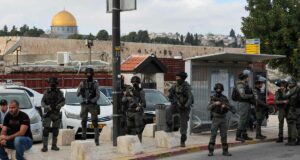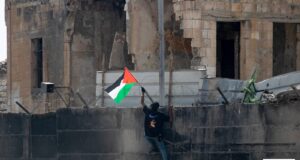Michael Sfard | Ha’aretz
3 September 2009
When my father was 21, he was arrested. Secret service agents tailed him everywhere for a few weeks, and the stress over whether and when he’d be shackled ate at him. Above all, it killed his aged parents. Many members of the student union were arrested with him. Each time the heavy iron door of his cell opened everyone’s heart skipped a beat. Who would they summon for interrogation now? Who would be spending the next 10 hours with the good interrogator and the bad interrogator?
During his many interrogations he wasn’t beaten or tortured, it was just the same questions, over and over: “Who are the leaders behind the riots?,” “Admit that you planned attacks on the security forces!,” “Who are your contacts abroad?,” “Who funds your subversive activities?” He ate well. He was never cold. But in the three months he was held his parents aged, from worry, and my mother cried rivers of tears. Warsaw, 1968.
That little village that was previously barely known even in Palestine became synonymous with the nonviolent Palestinian civil struggle and a place where Israeli and Palestinians demonstrate shoulder-to-shoulder. And now, two years after the High Court of Justice ruled that the separation fence built by the IDF there is illegal and ordered the state to redraw its route – two years in which the IDF has not carried out the ruling – the two generals concluded this was the time to smash this wonderful solidarity, to crush the Friday demonstrations in Bil’in.
But the special teargas grenades, with the increased range and the force of a small missile, represent an escalation even for Bil’in. In the neighboring village of Nil’in they caused critical head injuries to Tristan Anderson, an American demonstrator who has been lying in Sheba Medical Center, Tel Hashomer, for the past five months. Shortly after their introduction in Bil’in they killed Bassem Abu Rahme, a young man who never hurt a fly and became the first fatality of the demonstrations there.
After the special grenades came the nighttime raids. Their purpose was to arrest those who the army or the Shin Bet security services believed to be members of the village’s Popular Committee against the Wall, which organizes the demonstrations. For the past two months every few nights the children of Bil’in awaken to the screech of army Jeeps and stun grenades. Companies of soldiers under the command of the GOC Central Command, Gadi Shamni, and the commander of the IDF forces in the West Bank, Noam Tivon, break into homes, usually at 3 A.M., and arrest whoever they can grab: men, teens and children. Some are released a few hours later, others after a few days and still others remain under arrest on ridiculous accusations. No one touches the Israelis: even the major general and the brigadier general have their limits.
One of the detainees in these raids is among the leaders of the village’s organized protest, and anyone who believes in peace and coexistence can only hope he will eventually be one of the leaders of Palestine: Mohammed Khatib. In his early thirties, with youthful charm and charisma, Khatib is one of the architects of the Bil’in protests, the man who, with his friends, engineered the idea of the joint, nonviolent struggle. The Palestinian Martin Luther King, Jr. His creative mind has not rested during the past five years, every week coming up with a new exhibit, slogan, legal maneuver that will embarrass the regime, or for an article that will expose its lies and wickedness.
He is the one who coined the phrase, in reference to the settlers’ neighborhood that was built illegally on village land, “It’s not East Matityahu, it’s West Bil’in”: He came up with the idea of erecting, across from the illegal Israeli building project, the first Palestinian outpost – a seven-square-meter trailer home that within 24 hours was evacuated by a battalion of Israeli soldiers. (Who says no West Bank outposts are being evacuated?)
Khatib’s wife, Lamia, and their children remained alone in their home on the night that Mohammed was arrested. A few nights later the Jeeps returned, turned the family out of their beds and summoned Mohammed’s father for questioning. Maybe they thought that whatever they couldn’t get out of Mohammed before he’d tell them after learning that his elderly father was also interrogated.
After Khatib was released – with a prohibition against taking part in the Bil’in demonstrations – the Jeeps returned to the village once again and arrested Mohammed Abu Rahme, 48 (“Abu Nizar”), the vice president of the village council. Bil’in 2009.
The people who ordered the arrests of Khatib, Abu Nizar and dozens of their colleagues, some of whom are still in custody (such as the taxi driver Adib Abu Rahme, who has been rotting in jail for two months already, accused only of being a member of the Popular Committee), are ignoramuses who have not learned a single lesson from the human history of liberation struggles. They believed that this was the way to break the Bil’in protest movement – which, judging by the most recent demonstrations, has only grown greater in the wake of their actions.
I had the opportunity to peek into Khatib’s remand hearing in military court. (He was not present, because the Israel Prison Service forgot to bring him to the session…) I saw the military prosecutor speaking with pathos about the need to keep him in custody, about his being a “security risk.” Just like my father and his friends in Warsaw in 1968, when they organized demonstrations against the regime and for democracy. There, too, the authorities arrested the leaders of the protest in an effort to make them disappear. There, too, the arrests were made in the predawn hours. There, too, there were police officers who made the arrests, secret service agents who carried out the interrogations, prosecutors who prosecuted and judges who judged. And there, too, each one was a small but essential cog in a huge machine whose purpose was the control and oppression of millions.
Many good Israelis oppose the occupation but are disgusted by any attempt to compare the government we shaped in the West Bank with history’s detestable totalitarian regimes. Indeed, historical comparisons are dangerous. Warsaw circa 1968 does not resemble Bil’in circa 2009. The conflict is different, the struggle is different, the world is different. But there is something common to all attempts to oppress human beings. And as time passes, what they have in common outweighs the differences.
Michael Sfard is the lawyer representing the village of Bili’in in its struggle against the West Bank separation fence, which was erected on its land.
 International Solidarity Movement Nonviolence. Justice. Freedom.
International Solidarity Movement Nonviolence. Justice. Freedom.


